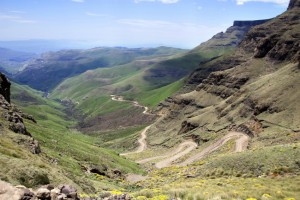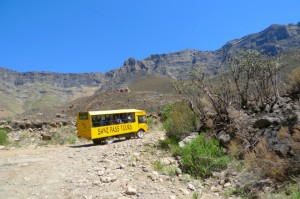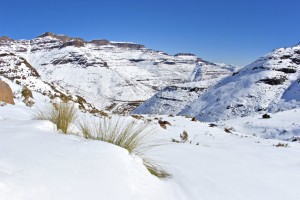Lesotho is all too often overlooked by African travellers, but once people venture into its borders, they often find their hearts stolen. This small but perfectly formed nation sits entirely above 1000 meters and is completely encircled by South Africa. Its meandering rivers and roads, jagged mountain peaks, smiling faces, and limpid cobalt skies combine to make the “Kingdom in the Sky” a place that once visited is difficult to leave, and there’s a surprising amount to do there. Here are eight ways to have a great Lesotho experience.
Hike the national parks
When you think of national parks in Africa, you probably think of elephants and giraffes silhouetted in front of an improbably large fluorescent sunset, or big cats lazing under acacia trees. Lesotho’s parks don’t boast any big game, but what they lack in animal encounters they more than make up for in solitude, remote hikes, and rugged beauty. For a truly off-the-beaten-path experience, head to Sehlabathebe National Park in Lesotho’s hard-to-reach southeastern corner. This is true wilderness hiking, so come fully equipped. And don’t forget spare batteries and camera memory cards — the scenery and prolific birdlife will ensure that you’re constantly snapping. Easier to reach but no less beautiful, Ts’ehlanyane National Park has a good network of walking paths. If you’re feeling particularly strong, tackle the 39km trail to the Bokong Nature Reserve, home to yet more impressive scenery.
Drive along winding roads
It’s close to impossible to find a Lesotho road that doesn’t make you want to jump out for a string of photos at every available place to pull over. Enter at Tele Bridge in the South and head east, where the road snakes alongside the impressive Senqu (Orange) River. The Central Highlands are home to rolling green hills dotted with rural homesteads and the occasional herder. Further east, the scenery gets more dramatic and the passes more breathtaking. Stop when and where you can both to fill up on photos and to steady your nerves — back-to-back hairpin bends are as much a feature of the landscape as the donkey-drawn carts you’ll be overtaking on many of the routes you drive.
Go horseback riding through the highlands
Without doubt the country’s most famous outdoor activity is a pony ride along some of the less accessible mountain paths. The Basotho ponies are famed for their sure-footedness, navigating chunky boulders and riverbeds as well as tamer terrain. Malealea, a small village in the west of the country, has become the quintessential place to saddle up and explore for a matter of hours or days. Opportunities to take to the saddle exist throughout the country though, some visiting rural villages and others simply taking in the ravines, peaks, and rivers that characterize Lesotho’s landscape.
Cycle an iconic pass
The vertiginous Sani Pass is the only road connecting Lesotho to South Africa’s KwaZulu-Natal province. Its countless bends and rugged unsealed surface make it a favorite with 4×4 drivers, but if your nerves are of the steel variety, the pass can also be tackled on a bicycle. The road stretches just over 20km, but rises 1000m and comprises 20 switchback bends in one short section. Whether you start in Lesotho or South Africa, you’ll likely fancy a beer at “Africa’s highest pub”, the Sani Top Chalet at 2874m, either to steady your nerves for the downward leg, or to reward yourself after making it to the top!
Shop for tapestries
Lesotho’s landscape makes for a perfect adventure sports destination, but it’s not all about hiking and biking. The strong Basotho culture also offers some distinctive shopping experiences, particularly in and around the crafty town of Teyateyaneng. Here, artisans weave scenes of Lesotho life into wall hangings that make ideal souvenirs. Even if you’re not buying, the town is worth a visit so you can watch the artists in action. Nearby Leribe is also worth a visit for its craft shopping, or if you’re in Maseru, visit the Basotho Hat Building to buy handicrafts from around the country.
Ski down African slopes
Weather-wise, skiing in Africa might seem an oddity, but Lesotho’s highland winters are cold, with snow often dusting the higher peaks. Sitting in the north east of the country, AfriSki gives travellers another way to experience the Maluti Mountains. The resort opens for three months in the Southern Hemisphere winter (mid-June to mid-September), its sole slope attracting South Africans, a handful of international travellers and even the occasional Basotho herder checking out the on-piste action. At either end of the season, the resort is so quiet you might even get the slope to yourself for an hour or so — a far cry from the crowded runs of Europe or North America.
Admire millennia-old rock paintings
The nomadic San people were the first inhabitants of Lesotho and South Africa, and their etchings line the walls of caves and overhangs throughout the region. All-too-often, these paintings are found in remote spots tucked away in the mountains — great for avid hikers, but not so convenient for the traveller with limited time. Luckily though, Lesotho is home to several easily accessible rock art sites. Easiest to visit and with superb information on the history and significance of the paintings is the Liphofung Cave. Close to the Caledonspoort border post, the cave has a long and interesting history, which includes a stint when the much-loved Basotho King Moshoeshoe lived there.
Abseil the country’s highest waterfall
Semonkong, in southern Lesotho, is the base for tackling the Maletsunyane Falls, a 196m-high, single drop waterfall, and the country’s highest. Semonkong means “Place of Smoke” and the small village is named for the mist that rises from deep within the gorge. Some hike to view the thundering cascade, others traverse the area on horseback, but those seeking an adrenaline fix can opt to plunge down the falls attached to a rope. The 204m abseil — dubbed the longest commercial abseil in the world — is so intense it comes with an obligatory half-day of training before you’re allowed to attempt it. For something a little less terrifying, opt for a walk in the mountains, looking out for the spiral aloe — Lesotho’s national flower.





